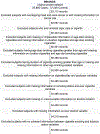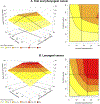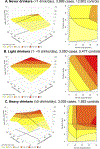Joint effects of intensity and duration of cigarette smoking on the risk of head and neck cancer: A bivariate spline model approach
- PMID: 31178212
- PMCID: PMC7117823
- DOI: 10.1016/j.oraloncology.2019.05.006
Joint effects of intensity and duration of cigarette smoking on the risk of head and neck cancer: A bivariate spline model approach
Abstract
Objectives: This study aimed at re-evaluating the strength and shape of the dose-response relationship between the combined (or joint) effect of intensity and duration of cigarette smoking and the risk of head and neck cancer (HNC). We explored this issue considering bivariate spline models, where smoking intensity and duration were treated as interacting continuous exposures.
Materials and methods: We pooled individual-level data from 33 case-control studies (18,260 HNC cases and 29,844 controls) participating in the International Head and Neck Cancer Epidemiology (INHANCE) consortium. In bivariate regression spline models, exposures to cigarette smoking intensity and duration (compared with never smokers) were modeled as a linear piecewise function within a logistic regression also including potential confounders. We jointly estimated the optimal knot locations and regression parameters within the Bayesian framework.
Results: For oral-cavity/pharyngeal (OCP) cancers, an odds ratio (OR) >5 was reached after 30 years in current smokers of ∼20 or more cigarettes/day. Patterns of OCP cancer risk in current smokers differed across strata of alcohol intensity. For laryngeal cancer, ORs >20 were found for current smokers of ≥20 cigarettes/day for ≥30 years. In former smokers who quit ≥10 years ago, the ORs were approximately halved for OCP cancers, and ∼1/3 for laryngeal cancer, as compared to the same levels of intensity and duration in current smokers.
Conclusion: Referring to bivariate spline models, this study better quantified the joint effect of intensity and duration of cigarette smoking on HNC risk, further stressing the need of smoking cessation policies.
Keywords: Bivariate spline models; Cigarette smoking duration; Cigarette smoking intensity; Head and neck cancer; INHANCE; Laryngeal cancer; Oral cavity and pharyngeal cancers.
Copyright © 2019 Elsevier Ltd. All rights reserved.
Figures





Comment in
-
Duration of Cigarette Smoking Is a Stronger Risk Factor Than Number of Cigarettes Smoked per Day for Head and Neck Cancer, and Quitting Dramatically Lowers the Risk.J Evid Based Dent Pract. 2020 Mar;20(1):101419. doi: 10.1016/j.jebdp.2020.101419. Epub 2020 Feb 19. J Evid Based Dent Pract. 2020. PMID: 32381417
References
-
- World Health Organization. WHO global report: mortality attributable to tobacco. Geneva: WHO; 2012.
-
- Ferlay J, Ervik M, Lam F, Colombet M, Mery L, Piñeros M, Znaor A, Soerjomataram I, Bray F (2018). Global Cancer Observatory: Cancer Today. Lyon, France: International Agency for Research on Cancer; Available from: https://gco.iarc.fr/today, accessed [21 March 2019].
-
- IARC. IARC Monographs on the Evaluation of Carcinogenic Risks to Humans, Volume 38 Tobacco Smoking. Lyon: IARC Press; 1986.
Publication types
MeSH terms
Grants and funding
- P01 CA068384/CA/NCI NIH HHS/United States
- R01 DA011386/DA/NIDA NIH HHS/United States
- R01 CA030022/CA/NCI NIH HHS/United States
- R01 ES011740/ES/NIEHS NIH HHS/United States
- R03 TW001500/TW/FIC NIH HHS/United States
- R01 DE016631/DE/NIDCR NIH HHS/United States
- R01 CA100679/CA/NCI NIH HHS/United States
- R03 CA113157/CA/NCI NIH HHS/United States
- P30 ES010126/ES/NIEHS NIH HHS/United States
- R01 DA011979/DA/NIDA NIH HHS/United States
- R13 CA210555/CA/NCI NIH HHS/United States
- R01 DE013158/DE/NIDCR NIH HHS/United States
- R01 CA078609/CA/NCI NIH HHS/United States
- K07 CA104231/CA/NCI NIH HHS/United States
- T32 CA009142/CA/NCI NIH HHS/United States
- U01 CA096134/CA/NCI NIH HHS/United States
- R01 CA090731/CA/NCI NIH HHS/United States
- R03 CA077954/CA/NCI NIH HHS/United States
- R21 ES011667/ES/NIEHS NIH HHS/United States
- R03 DE016611/DE/NIDCR NIH HHS/United States
- R01 CA048996/CA/NCI NIH HHS/United States
- R01 CA100264/CA/NCI NIH HHS/United States
- 001/WHO_/World Health Organization/International
- P50 CA090388/CA/NCI NIH HHS/United States
- R01 DE013110/DE/NIDCR NIH HHS/United States
LinkOut - more resources
Full Text Sources
- ArTS, University of Trieste, Access Free Full text
- Archivio Istituzionale della Ricerca Unimi - Access Free Full Text
- ClinicalKey
- Elsevier Science
- Enlighten: Publications, University of Glasgow - Access Free Full Text
- Europe PubMed Central
- HAL archives ouvertes - Access Free Full Text
- PubMed Central
- University of Turin Instituional Repository AperTO - Free full text
- eScholarship, University of California - Access Free Full Text
Medical

